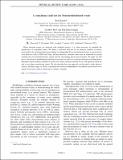Notice
This is not the latest version of this item. The latest version can be found at:https://dspace.mit.edu/handle/1721.1/136705.2
A coincidence null test for Poisson-distributed events
| dc.contributor.author | Essick, Reed | |
| dc.contributor.author | Mo, Geoffrey | |
| dc.contributor.author | Katsavounidis, Erik | |
| dc.date.accessioned | 2021-10-28T14:34:18Z | |
| dc.date.available | 2021-10-28T14:34:18Z | |
| dc.date.issued | 2021-02-05 | |
| dc.identifier.uri | https://hdl.handle.net/1721.1/136705 | |
| dc.description.abstract | When transient events are observed with multiple sensors, it is often necessary to establish the significance of coincident events. We derive a universal null test for an arbitrary number of sensors motivated by the archetypal detection problem for independent Poisson-distributed events in gravitational-wave detectors such as LIGO and Virgo. In these detectors, transient events may be witnessed by myriad channels that record interferometric signals and the surrounding physical environment. We apply our null test to a broad set of simulated gravitational-wave events as well as to a real gravitational-wave detection to determine which auxiliary channels do and do not witness real gravitational waves, and therefore which are safe to use when constructing vetoes. We also describe how our approach can be used to study detector artifacts and their origin, as well as to quantify the statistical independence of candidate gravitational-wave signals from noise artifacts observed in auxiliary channels. | en_US |
| dc.publisher | American Physical Society | en_US |
| dc.relation.isversionof | http://dx.doi.org/10.1103/PhysRevD.103.042003 | en_US |
| dc.rights | Article is made available in accordance with the publisher's policy and may be subject to US copyright law. Please refer to the publisher's site for terms of use. | en_US |
| dc.source | American Physical Society | en_US |
| dc.title | A coincidence null test for Poisson-distributed events | en_US |
| dc.type | Article | en_US |
| dc.identifier.citation | Phys. Rev. D 103, 042003 (2021) | en_US |
| dc.identifier.mitlicense | PUBLISHER_POLICY | |
| dc.eprint.version | Final published version | en_US |
| dc.type.uri | http://purl.org/eprint/type/JournalArticle | en_US |
| eprint.status | http://purl.org/eprint/status/PeerReviewed | en_US |
| dc.date.updated | 2021-02-11T02:59:48Z | |
| dc.language.rfc3066 | en | |
| dc.rights.holder | American Physical Society | |
| dspace.date.submission | 2021-02-11T02:59:48Z | |
| mit.license | PUBLISHER_POLICY | |
| mit.metadata.status | Authority Work and Publication Information Needed | en_US |
| mit.metadata.status | Authority Work and Publication Information Needed |
